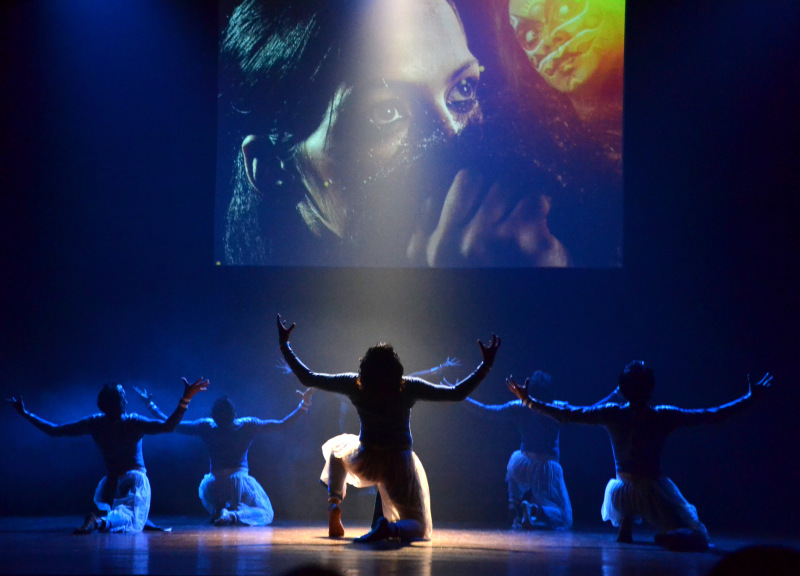Artistic director Mayuri Upadhya’s article about giving perspectives to Indian myths through dance was published in “The Asian Age”. Read here.
We live in a time when the most sensational stories make it to the headlines of the newspaper. From crime, politics to celebrity gossip it’s out there for us to bite into, like a juicy apple, and we do just that without questioning. We call it increasing our awareness: with people, the situation and the times. Very soon, today’s reality becomes a mere story tomorrow, buried between the pages of history.
But some of these stories are timeless. They have a golden voice of their own, characters that can provoke thoughts in a reader. They reach out, remain in the minds of people in a way they would have never understood otherwise. These are “myths”, magical, colorful tales that demonstrate human behavior and give us the worldview of the past eras. They carry in them spiritual teachings, philosophies and ideologies embedded in each culture. To understand one’s culture, a study of their mythology is a must. Every child, man and woman in India, at least till recent times, has grown up listening to tales of gods and demons, animals that can fly, monsters that live in the depths of the ocean and have stirred their imagination.
Some myths even have geographical sites, dates and places of occurrence mentioned to support the relevance of the story, which also goes to prove mythology and history overlap. Then why this mad rush to embrace history over mythology?
Popular mythologist Devdutt Pattnaik says, “Mythology is derived from the Greek word ‘mythos’ which means ‘story’. Classical Greek philosophers rejected mythos, in favor of logos, that which appealed to reason. Thus was born the divide between mythology and history”.
This divide even appears in our dance scenario between traditional forms and modern dance. While most traditional dancers find their inspiration in myths that transcend ordinary human life, contemporary dancers prefer to express their connect with current issues addressing our society and the global scenario.
From Ram Gopal’s depiction of Nataraja, Odissi guru Kelucharan Mohapatra’s rendition as Radha in the ashtapadis (from Jayadeva’s Gita Govindam) to the elaborate six-part Ramayana of Kalakshetra, the creations have taken their muse, inspiration and energy from myths.
Contemporary artists work with newer mediums, methods and abstractions, like London-based Shobana Jeyasingh’s culinary tribute “Just add water?” that centered the plot around the success stories of cross cultural eating or Jayachandran Palazhy’s multimedia production Trans Avatar, which explored multiple identities of the individual.
While the two schools of thought can exist in a parallel manner, what if there can be a possibility of continuity of these myths in our dancing with newer representations and perspectives?

Personally, I believe you can’t throw out your culture even if there are aspects of it that you may not be able to respond to. It’s in our blood. You live with them, question them, draw inspiration from them, and occasionally reject them only to return to them with a different sense of belonging. In one such composition of mine, I’ve explored the concept of ArdhaNareshwar, a traditional theme with a contemporary approach and context. In our myths ArdhaNareshwar is a manifestation of Shiva that
unites forces of male and female power, matter and energy, to display the perfectly balanced two-fold nature of the universe. Whereas today these divisions and gender roles are fading, these distinctions exist only externally. They don’t exist within the self. So, the whole dance was designed keeping a frontal view, exploring the movement vertically on a giant property of a trishul (trident). Likewise, in the “Game of Dice” by Sadhya dance company, even though the subject is from classic epic Mahabharata, the choreographer, Santosh Nair treats it on contemporary lines. The work looks into the conflicts of characters and finds co-existence of multiple truths relatable to the common man of modern times.

Today we have enough tools and methods to document events, but what about earlier times? The best way they could think of passing relevant information was with the medium available to them from stone carvings, writing to recitals of events in the most visual manner. Many an art form has emerged as a result of this. Out of them my favorite are Harikatha performers who use a pair of cymbals to keep beat and dance and narrate stories mingled with songs and anecdotes.
In the larger context, myths grant continuity and stability to a culture. The stories are topics for great art, literature and music. One finds them used in advertisements, in political cartoons and even names of organisations or businesses. Whether true or fictitious, they are the most imaginative stories entrusted to us from our heritage and hence it is our responsibility to preserve, promote and pass to the best of our capacity. When Harry Potter can become a bestseller worldwide and be turned into a musical, then why not celebrate our legendary heroes and villains?
0 Comments